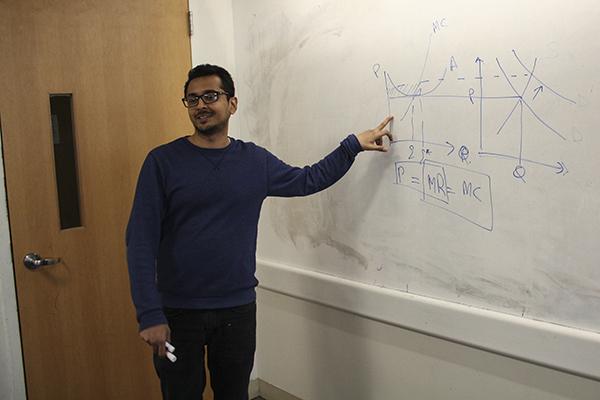Updated: Feb. 11, 2016 at 12:04 p.m.
Economics professors say they need a little more help, and teaching assistants are feeling the pressure.
Faculty in the department, which has seen a significant influx of students over the past few years, say there aren’t enough graduate teaching assistants to help conduct research, complete administrative tasks and teach discussion sections. The number of economics majors has increased 26 percent in the past five years, with 280 students now in the program and many more non-majors taking economics classes. TAs in the department said they feel strained and have more responsibilities than their peers in other departments, but are still paid the same amount.
Anthony Yezer, an economics professor, said students have complained about not being able to register for classes that are full, and fill quickly – a problem he said could be remedied by having more TAs available to teach discussion sections in larger lectures.
“We do not have enough TAs,” Yezer said in an email. “Unless things change, we will not have enough TAs to staff the current discussion sections and will need to cut back further on availability of undergraduate instruction.”
Yezer also said the strain on TAs could have broader consequences – students who have been accepted to the doctoral program sometimes choose to attend other universities because the workload is lighter and the pay is better.
The 28 TAs currently employed by the economics department are paid an average of $22,500 per year. When The Hatchet last reported on the compensation of TAs in the economics department in 2012, former Provost Steven Lerman had recently raised the standard package to $20,000. TAs at peer schools like Emory, New York and Vanderbilt universities were being paid between $2,000 and $5,000 more at the time.
Departments in the Columbian College of Arts and Sciences were hit with a hiring freeze in 2014 after graduate enrollment unexpectedly dropped, and some graduate students saw their financial aid shrink.
Jeffrey Brand, the associate dean for graduate studies, credits TAs in the economics department with providing expertise and individualized help for students.
Brand said that TAs are not permitted to work more than 20 hours per week and they receive salaries based on their weekly workload in addition to stipends and scholarships.
“The number of graduate assistants in a department varies based on several factors, including course demand and the number of available graduate students,” Brand said in an email.
Brand declined to say how many TAs the economics department or CCAS hired this year or over the past five years.
Abilasha Sahay is a microeconomics TA for economics professor Irene Foster. Last semester, Sahay’s first, she had nearly 75 freshman across her several discussion sections.
Sahay said her peers in other departments have far fewer responsibilities, although they are paid the same amount. She said that more compensation would be welcomed by TAs supporting themselves in D.C.
“That’s where I feel that maybe it needs to be realigned a bit,” Sahay said. “D.C. is a relatively costly place to be, so any time you are able to get by and have something for yourself, I think it’s fine, but definitely it’s not something with which you can really plan your future.”
James Foster, a professor of economics and international affairs, said that more TAs would improve the economic department overall, creating more research opportunities. He also said the department currently does not have enough funding to offer scholarship and compensation packages to potential doctoral students.
“The fact is that the total pool of money appears to be unable to attract the numbers that a department like economics, which is expanding the number of students at the undergraduate level, will need,” Foster said.
Amjad Khan, a TA in the economics department, said that while TAs are technically not permitted to work more than 20 hours per week, the TA workload varies for each course.
“Economics departments at most colleges seem to be underfunded as compared to, say, the business schools or the public policy schools,” Khan said. “Money flows to where all the real money is, I guess.”
Mark Connolly, a higher education expert at the University of Wisconsin, said department funds are the key factor in determining how many TAs they can have available for faculty.
“The more graduate students you have working, the more you have to pay,” Connolly said. “Depending on whether you have to pay their tuition on top of their salary, it can get expensive.”
Connolly said that overworked or underpaid TAs can be detrimental to the quality of the class.
“Enthusiasm of the instructor plays a huge role for the student to engage in that topic,” Connolly said. “If the TA is not interested, it is unlikely that the undergraduates will be as well.”
This post was updated to reflect the following correction:
The Hatchet incorrectly reported that Abilasha Sahay had 800 students in her discussion sections. She had 75 students in her discussion sections. About 800 students overall took economics professor Irene Foster’s course. We regret this error.







